Text
Been on a bit of a hiatus, sorry about that. Still kinda busy with various things but hoping to get the next post up innnnn a couple weeks, will see.
0 notes
Text
Senku Cola

The stuff that runs through our beloved Gen’s veins! But what makes it so bubbly? Today, I’ll cover the carbonated water that Senku uses to make Senku Cola in Ch 40.
Carbonated water is produced by dissolving carbon dioxide in water, in this case artificially injected under pressure. Carbonic acid (pH 3-4) is created when the CO2 gets dissolved, giving the carbonated water that slightly tart flavor. The chemical equation for this is
H2O (l) + CO2 (g) ⇌ H2CO3 (aq)
The double arrow means that the reaction can go either way, as carbonic acid can break back down into water and carbon dioxide.
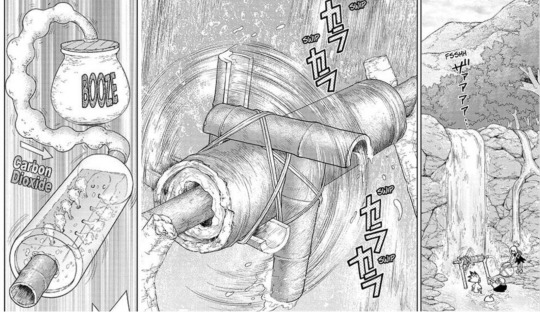
In the image above, on the far left, you can see the CO2 being piped in from that barrel of booze. If you remember from the alcohol post, CO2 is one of the by-products of ethanol fermentation when making wine. The spinning tube is most likely completely sealed, so the water and injected CO2 would be under pressure. The higher the pressure and the lower the temperature means that more CO2 will be dissolved in the water. That’s why, when you open a can or bottle of cola, the CO2 fizzes out and escapes in gas bubbles since the solubility decreases once the pressure is released.
In the middle of the image, the tube of water is being spun by the waterfall. I’m not 100% sure what the purpose of this is, but maybe it’s to help dissolve the CO2 by sloshing the water around in the pressurized gas? Or maybe it’s to cool down the water to increase how much CO2 gets dissolved.
But once you have carbonated water, you can make...
Sodium Bicarbonate!

And also cola. :)
I’ll cover all the happy fun chemistry stuff involved in the rest of the sulfa drugs roadmap next. Get excited!
Any questions or corrections, send an ask!
Sources
https://en.wikipedia.org/wiki/Carbonated_water
https://en.wikipedia.org/wiki/Henry%27s_law
14 notes
·
View notes
Text
Alcohol
Continuing with the sulfa drugs roadmap, it’s time for alcohol! As a note, this isn’t a how-to article or anything of the sort, so you probably shouldn’t try to DIY based off of this post lol.
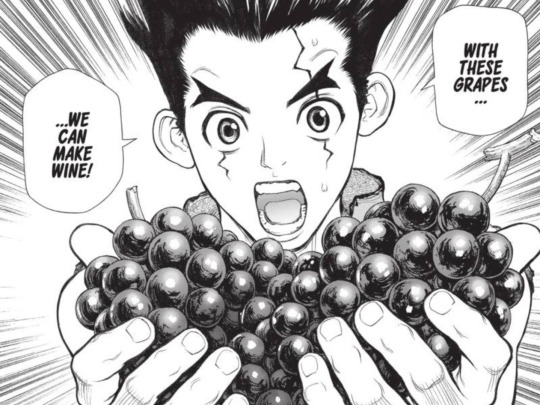
Senku and Taiju first make alcohol using some wild grapes Taiju found in Ch 2. To do this, they smash up a bunch of grapes and let the juice and everything sit for a few weeks, stirring every now and then so that the grape pulp doesn’t go dry. During this time, the yeast found on the grape skins, or in the air, produce ethanol as a by-product of anaerobic respiration.
Ethanol fermentation, or alcoholic fermentation, is when glucose (sugar) gets converted into cellular energy in the absence of oxygen, with ethanol and carbon dioxide as by-products. The overall chemical equation is:
C6H12O6 (glucose) → 2 C2H5OH (ethanol) + 2 CO2
Vinegar
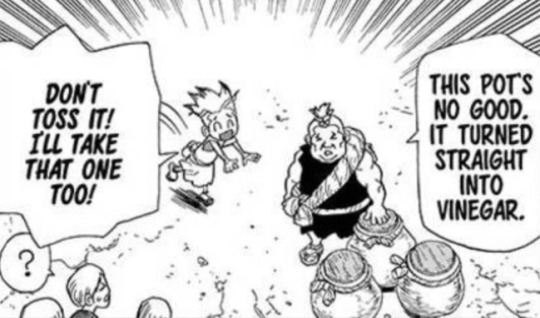
As mentioned in Ch 40, from the wine, we can also get vinegar, which is an aqueous solution of acetic acid (CH3COOH). This is usually produced by the fermentation of ethanol alcohol or sugars by acetic acid bacteria, which are found pretty commonly in nature, like floating in the air and stuff. The word “vinegar” actually comes from some old Latin and French words meaning “sour wine”.
The equation for producing acetic acid from ethanol and oxygen is:
CH3CH2OH + O2 → CH3COOH + H2O
(Same formula for ethanol, just written differently)
And then from acetic acid, we can get acetic anhydride, but I’ll cover that in a future post. If you have any questions or corrections, drop them in my box!
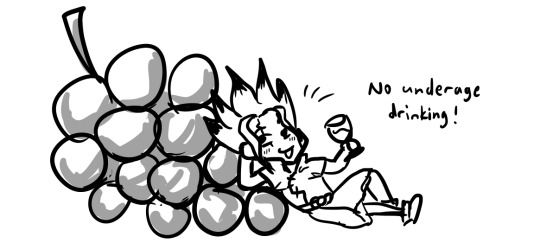
Sources
https://en.wikipedia.org/wiki/Winemaking
https://en.wikipedia.org/wiki/Fermentation
https://en.wikipedia.org/wiki/Ethanol_fermentation
https://blog.eckraus.com/stirring-the-wine-must
https://en.wikipedia.org/wiki/Vinegar
https://en.wikipedia.org/wiki/Acetic_acid_bacteria
Doodle by me
#dr stone#dr. stone#dcst#chemistry#biology#alcohol#vinegar#sulfa drugs#didnt go into detail with the anaerobic respiration but i can add that in if anyone wants
4 notes
·
View notes
Text
Electricity: Dynamos

After obtaining strong magnets, it’s time to generate electricity! In Ch 25, Senku accomplishes this in the stone world by building a dynamo, or rather the precursor to modern dynamos. What he makes is specifically a homopolar generator, also known as a disk dynamo or Faraday wheel, among other names, and was developed by our good friend Michael Faraday.
So how does this thing work? Remember Faraday’s law from the previous magnet post, how moving a coil in a magnetic field can induce a current? The same thing is happening here: when the copper disk spins, the electrons in the part that passes through the magnetic field start moving. This creates an electromotive force (emf), which is actually the amount of energy per unit of charge, rather than an actual force.
If you look closely at the image above, you can things connected to the edges and axles of the disks. Or here’s a clearer diagram from the manga:
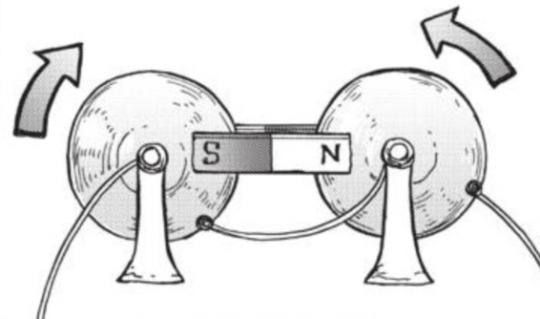
There’s a potential difference (or voltage) between the edge and the center of each disk, and when you close the circuit with something like a lightbulb or bamboo fiber (called an electrical load, whatever is consuming the electrical power), an electric current starts to flow.
This kind of dynamo is actually pretty inefficient when it comes to generating voltage, due to counterflows of current where the current would flow backwards outside of the magnetic field. The original Faraday wheel actually just had one of those wheels, but by linking two of them up in series like this, the voltage produced is doubled. Plus the disks are really big, so that probably helps. I don’t remember which chapter this was mentioned, but I believe Kinro and Ginro were able to produce 3 volts of electricity by spinning these things.
I found a couple videos as well, describing how these dynamos work, which I’ll put below the cut.
As always, if you have any questions or corrections, send them my way!
Sources
https://en.wikipedia.org/wiki/Dynamo
https://en.wikipedia.org/wiki/Homopolar_generator
http://hyperphysics.phy-astr.gsu.edu/hbase/electric/farlaw.html
https://www.britannica.com/science/electromotive-force
https://en.wikipedia.org/wiki/Electromagnetic_induction
https://en.wikipedia.org/wiki/Voltage
https://edisontechcenter.org/generators.html
I dont think I used this one but there’s more stuff on generators and dynamos (the more modern type of dynamo, rather than a Faraday wheel)
Videos
youtube
youtube
Fun fact: Senku’s E=MC2 gets changed to the equation for Faraday’s law (and Lenz’s law, from the negative sign) on the cover of Z=25.

#dr stone#dr. stone#dcst#physics#electricity#dynamo#sulfa drugs#bit later than usual bc work is sucking my soul out
4 notes
·
View notes
Text
Magnets from Lightning

One of the first steps Senku takes to make sulfa drugs for Ruri is to generate electricity using strong magnets. Senku and the gang used the magnetic rocks that Chrome had found in order to collect iron sand, but these magnets aren’t strong enough to generate the electricity that Senku needs.
This post is pretty dang long because magnets and magnetism are So Much, so the rest is under the cut.
For strong magnets, made in Ch 24-25, Senku references the work done by NASA scientist Peter Wasilewski, who conducted experiments on creating magnets with lightning. These experiments were conducted in areas of the USA with lots of lightning activity, like in New Mexico.

(They spelled his name wrong in the translation haha)
Lodestones
You’ve probably heard of these before, the naturally occurring magnets often used in ancient times for early navigation. They were also used in Dr. Stone to collect iron sand from the river. Lodestones are made of a mineral called magnetite, which is made of iron and oxygen (Fe3O4) and is the most magnetic of all naturally occurring minerals on earth. However, while ordinary magnetite is attracted to magnets due to being full of iron, it doesn’t usually get magnetized itself due to its low magnetic coercivity (how well it can stay magnetized).
There’s actually another mineral found in lodestones called maghemite (cubic Fe2O3) along with other impurities of metal ions. The maghemite hecks up the crystalline structure of magnetite so that its magnetic coercivity is high enough to stay magnetized and become a permanent magnet.
So where does lightning come into play? Well, how do these rocks get magnetized in the first place? Permanent magnets are made when an object gets exposed to an external magnetic field and then stays magnetized. The Earth’s magnetic field isn’t strong enough to magnetize a lodestone on its own, and lodestones are found at the Earth’s surface, usually in high and exposed places, rather than anywhere deep underground, so the leading theory is that these rocks become magnetized after being struck by lightning bolts, which have strong magnetic fields surrounding them.
Wasilewski’s Lightning Experiments
Wasilewski found evidence of this theory by experimenting with zapping rocks with lightning. It’s a little similar to the story of how Ben Franklin drew lightning by flying a kite out in a storm with a metal key attached, but instead of a kite and key, Wasilewski used a small rocket attached to a long (like 3 miles long) metal wire. The other end of the wire was attached to a box with a sample of unmagnetized magnetite inside.
When the rock was struck (I’m assuming the rocket attracted lightning and got hit, and all the electricity from the lightning flowed through the wire to the box), it was exposed to the lightning bolt’s strong magnetic field, and when the lightning and its field went away, some residual magnetism, or remanent magnetization, was left in the rock, enough to pick up some paperclips at least.
Back to Magnets
What makes something magnetic? The answer takes you down into subatomic space with electrons and their “spin”. An electron’s spin can only be in one of two states: its magnetic field pointing either “up” or “down”. The way the electrons spin is the main source of ferromagnetism (the kind we’re dealing with right now). When enough electrons have their spins pointing in the same direction, and more than the number of electrons spinning the other way, this adds up to a larger magnetic field. Iron is one of the elements that has enough electrons spinning one way than the other, so it’s attracted to magnets and can also be magnetized.
(There’s some more complicated stuff about electrons and magnetism, but this post is already getting super long so we’re skipping that.)
Copper Wire
So what’s the copper wire for? Copper is a nonmagnetic metal, so why does Senku wrap the iron in it?
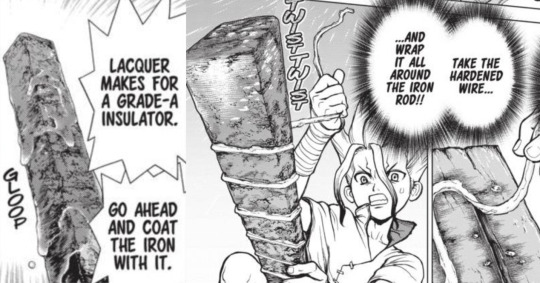
I haven’t found any direct answers to this question yet, but my best guess is that Senku is making use of Ampere’s Law, Faraday’s Law of Induction, and/or Lenz’s Law so that the magnets will be polarized properly. This is based on how, when Kohaku held the magnets such that they repelled each other, the coil marks on the bars were going the same direction.

And when the magnets attracted each other, the coils were going in opposite directions.

Ampere’s law describes how a magnetic field can be created inside a coil of wire when the wire has a current running through it. The magnetic field inside the coil would go in one direction, depending on the direction of the current through the coil. This is how electromagnets work. The electric current for Senku’s copper coil probably came from the lightning, and the lacquer coating the iron bar would probably then be to insulate the bar from the coil so that the current would only run through the coil. The iron bar inside the coil would then be exposed to a magnetic field that, along with the lightning’s own magnetic field, would be enough to magnetize the iron bar.
Faraday’s law has to do with how changes to the magnetic environment of a coil can induce a voltage (and thus produce electricity) in the coil. Both the iron bar and the wire were exposed to the lightning bolt’s magnetic field, and there would definitely be a couple big changes to the magnetic environment of the wire with how lightning comes and goes in a literal flash. The induced current from the lightning’s magnetic field could also contribute to the stuff in the previous paragraph.
Lenz’s law determines the direction or polarity of the induced current in the coil, from Faraday’s law. Whatever direction the change in the magnetic field that induced the current was going, the current will run so that the magnetic field inside the coil will go the opposite direction. For example, if you push the north end of a magnet into a coil of wire, then the magnetic field in the coil produced by the induced current in the wire will point out of the coil, in the opposite direction that the magnet is moving.
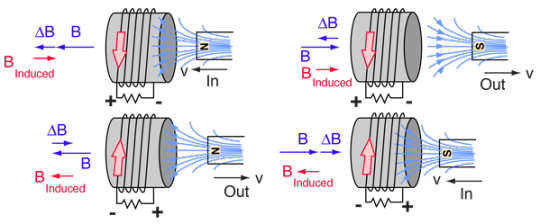
(Image from the hyperphysics link in the sources. For directiony things, magnetic fields “flow” from north to south.)
(Additionally, I think this law is also related to the remanent magnetization of the iron bar after getting zapped. The magnetic field of the iron bar would then be opposite of the field that magnetized it. I’m only about 80% sure though, since I can’t find where in my sources I might’ve read this. But it makes sense with conservation of energy and stuff, right?)
Combining all this together probably adds up to establishing polarity in the iron bar, and the handy marks from the coil would indicate which way the poles are facing.
As for the actual use of copper, copper material gets really funky around changing magnetic fields. While copper on its own isn’t magnetic, it can become temporarily magnetized in little sections, via electrical eddy currents, close to where a magnetic field is passing by or otherwise changing. You can see this when dropping a magnet down a copper tube, where the magnet falls in slow motion as the induced magnetic field from the copper tries to repel the magnet and its descent. Maybe this is important for magnets, too.
If you made it all the way to the end, 10 billion points to you! It is 1am and I do not want to think about electricity and magnetism anymore, so this post won’t be proofread as much as the previous posts have been.
If you have any questions or want further elaboration or clarification on anything in this post, or if you found any errors in my explanation, please feel free send me an ask! The next post in the sulfa drugs series will be on generating electricity with these magnets! :’)

Sources
https://www.researchgate.net/publication/248812790_Lodestone_nature's_only_permanent_magnet_What_it_is_and_how_it_gets_charged
(Full-text pdf should be free to download)
https://www.cambridge.org/core/services/aop-cambridge-core/content/view/S0883769415001116
https://en.wikipedia.org/wiki/Lodestone
https://en.wikipedia.org/wiki/Magnetite
https://en.wikipedia.org/wiki/Ferromagnetism
https://en.wikipedia.org/wiki/Remanence
http://hyperphysics.phy-astr.gsu.edu/hbase/electric/farlaw.html
(Source of the Lenz’s law diagram)
https://en.wikipedia.org/wiki/Electromagnet
(Also explains Ampere’s law)
http://terpconnect.umd.edu/~wbreslyn/chemistry/is-copper-magnetic.html
9 notes
·
View notes
Text
Sulfa Drugs - Masterpost
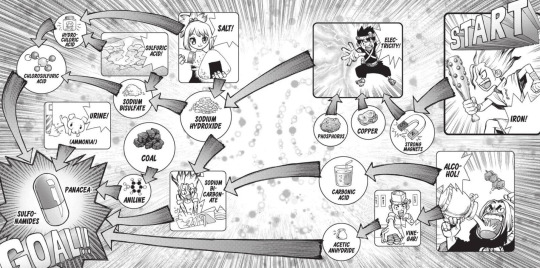
The cure-all antibiotic for Ruri’s disease! Also known as sulfonamides!
Covering all the steps in a single post is way too much for me to do, and probably too much for most people to read, so I’ll fill this post in with links to each part of the process as I post them. Some steps in the road map may also get rolled up into other posts for personal convenience.
Strong magnets
Electricity
Alcohol (+vinegar)
Carbonic acid
Etc.
6 notes
·
View notes
Text
Kinro’s Gold Spear

In Ch 19, Senku tries to bribe win Kinro over by making him a golden spear to fit his name, done by a process called fire gilding. This is an ancient art used to coat things like metals in a layer of gold, with more intensely saturated results than from modern day electroplating. However, the process is pretty involved, and comes with various health risks due to the use of mercury.

You can’t mix mercury and gold by melting them together because mercury vaporizes (turns into gas) at a relatively low temperature. Instead, you’d mix them by grinding them together with a mortar and pestle, like Senku is doing above. This is to create a paste or amalgam of gold which, once cooled to a certain point, can be spread onto something like a spear tip. It looks like Senku just dips the spear tip into the amalgam, but it’s actually applied to things by using a brush or spatula-shaped rod.

Then to get rid of the excess mercury, Senku heats the spear tip in a fire to evaporate it out. The smoke is full of mercury, which is very much not good for the body if absorbed in any way (including through the skin! Senku’s not being very safe here).
There are a few more steps involved in fire gilding, like preparing the object to be gilded by cleaning it in diluted nitric acid and then “quicking” the surface with mercury before applying the amalgam, but Dr. Stone just covers the basics. You can read more about the process in the sources I’ll list below.
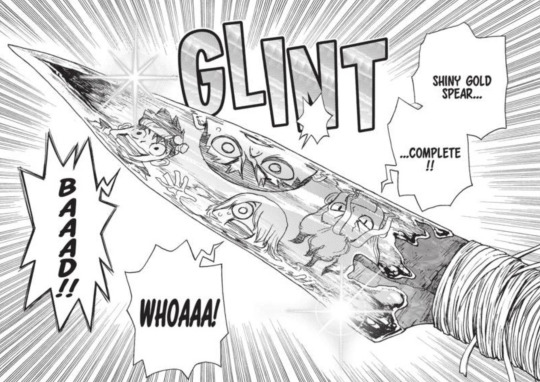
Any questions, corrections, or requests can be dropped in my askbox! I’ll be working on sulfa drugs next.
Sources
https://en.wikipedia.org/wiki/Gilding
http://gluedideas.com/Encyclopedia-Britannica-Volume-10-Part-1-Game-Gun-Metal/Chemical-Gilding.html
(The text about fire gilding seems to be the same in the above two sources. Pick whichever one to look at.)
https://www.ganoksin.com/article/ancient-art-fire-gilding/
9 notes
·
View notes
Text
Levers
I left off on the last post with the question of how Senku based his pulley calculation on a mass of 500kg when he estimated the tree to be around 1000kg.
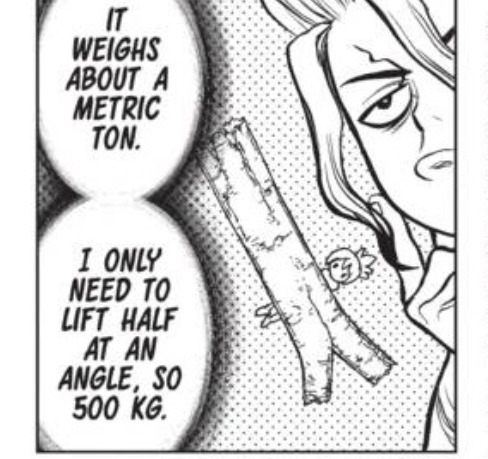
You could probably sort of conceptualize it as the rope and pulleys holding up half the tree’s weight and the ground holding up the other half, but how does this actually work?
The tree is a lever, another simple machine, and specifically a second class lever where the fulcrum, or pivot point, is on one end of arm (where the tree touches the ground), the load or resistance is somewhere on the middle of the arm, and the lifting force, or effort, is applied on the other end of the arm. Another real-world example of a second class lever is the wheelbarrow.
We can assume that the mass of the tree is evenly distributed along the whole tree, so the load is in the middle of the tree, where the center of gravity is.
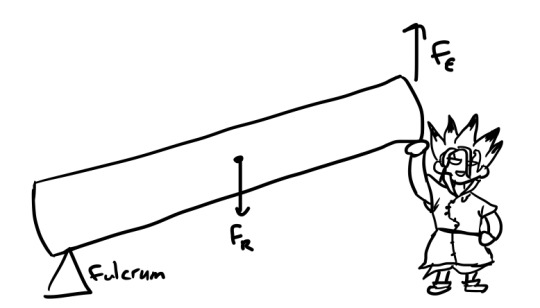
So how is the upward force (the effort) equal to half of the downward force (the load)?
There are some equivalenty balancy things going on with torque or energy or work, since simple machines can’t create or destroy energy. Essentially, you want the product of the force of the load and the distance from the fulcrum a to be equal to the product of the force of the effort and that distance from the fulcrum b. (Torque is actually the cross product of force and radius, used for rotational things like this, so you could also say to balance the torques.)
F(r) x a = F(e) x b
F(r) is the force of the load, which is 10,000N downwards for the weight of the tree (1000kg * 10m/s/s gravity’s acceleration), and a is the distance of the load from the fulcrum, which is at the halfway point along the length of the tree.
On the other side of the equation, F(e) is the force of the effort, the upward force when Senku is pulling up on the tree with the rope and pulleys (or pushing up in my little doodle), and the distance b is the whole length of the tree, or twice the length of a.
10,000N x a = F(e) x 2a
Using some fancy algebra, you can take out the a from each side, leaving
10,000N = F(e) x 2
So the force that Senku has to exert on the other end of the tree is half of 10,000N, or 5000N, thus needing to lift 500kg of tree.
But wait! There’s more!
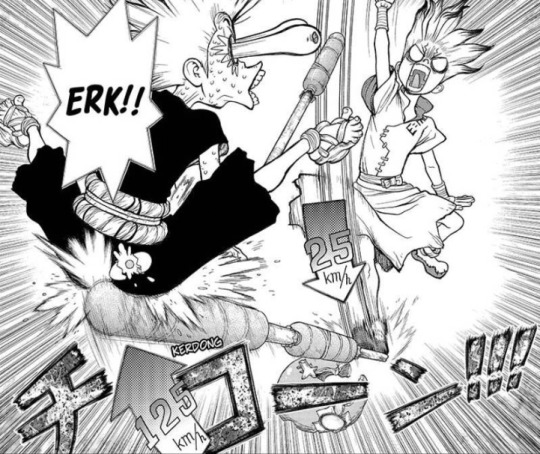
Senku uses a lever in Ch 39 as well, in his match against Ginro during the Grand Bout. This time, it’s a first class lever, where the fulcrum (Suika’s helmet) is in between the load and the effort.
The emphasis here is more on the tangential velocities of the two ends of the pole, rather than the mechanical advantage (how much force you use with the machine compared to without the machine) of the lever.
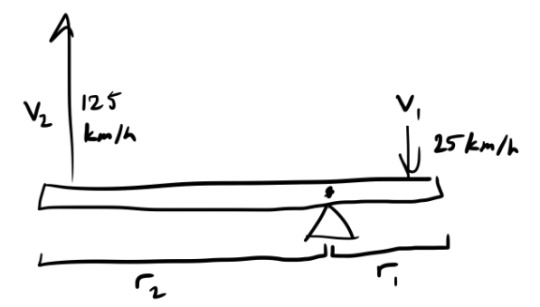
From the hyperphysics page I’ll link in the sources, “[f]or an object rotating about an axis, every point on the object has the same angular velocity.” This means that every point along the pole is rotating about the fulcrum with the same angular velocity ω, which is a measure of the angular displacement (how much of an angle something rotates around a circle) over time. Tangential velocity v is found by multiplying the angular velocity by the radius r (the distance from the fulcrum), so we get these equations:
v1 = ω * r1
v2 = ω * r2
Rearranging the equations, and keeping in mind that ω is the same in both equations, we get
v1/r1 = ω = v2/r2, or
v1/r1 = v2/r2
So the tangential velocities and the radii are directly proportional. Since 125 is 5 times 25, we can tell that the length of the segment of the pole hitting Ginro, r2, is 5 times longer than the segment that Senku is stomping on, r1. It would also take Senku 5 times the force to stomp on the pole and lift the other end, but he’s putting his whole body weight into it, and anything with enough mass going 125 km/h (or 77.67 mph) straight into your crotch would probably hurt a lot regardless :D
If you have any questions on or corrections to this post, or have any suggestions for what to post about next, send me an ask!
Sources
http://www.oswego.edu/~dristle/PHY_206_powerpoints/Simple%20Machines5.14.pdf
https://en.wikipedia.org/wiki/Lever
https://en.wikipedia.org/wiki/Mechanical_advantage
https://en.wikipedia.org/wiki/Torque
http://hyperphysics.phy-astr.gsu.edu/hbase/rotq.html
Non-manga drawings by me
5 notes
·
View notes
Text
Pulleys
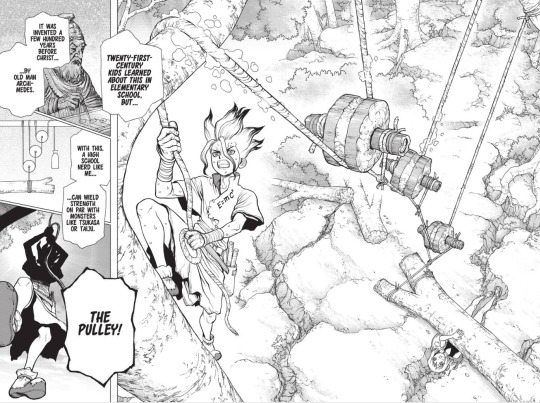
I don’t remember elementary school, but I do remember being sick or something the day my high school physics class started learning about tension, so I never really understood pulleys very well until now (hopefully).

A pulley is a simple machine that can change the direction of a force. If you don’t want to pull up to lift a box, you can use a pulley to change the direction and pull down instead, using the same amount of force. But that doesn’t really work to lift 500kg of tree, the way Senku does here in Ch 16.
As you can see in the first image, Senku uses 3 pulleys in order to lift a tree weighing about 5000 Newtons (500kg of tree mass * 10m/s/s of acceleration due to gravity), using his own weight of about 600N (from 60kg).

Senku’s pulley system uses 3 moveable pulleys, plus one fixed “pulley” from the loop around the tree that he pulled down on (right above the little sack in his diagram). From left to right, each moveable pulley cuts the force that the next pulley has to carry in half. Why is that?

Here’s a rough diagram of the forces at play (making various assumptions like ignoring the weights of the pulleys themselves and ignoring that Senku’s weight here isn’t enough to keep the system at rest, plus ignoring friction that Senku reduced by lathering the rope with soap). Hopefully you can read the numbers, but essentially the two sides of the rope holding one pulley up are under equal amounts of tension, the sum of which being equal to the tension pulling the pulley down. This means that the force on one side of the rope pulling up is equal to half the force pulling down.
For example, taking the lowest pulley that is attached to the tree:

The weight of the tree is exerting 5000N of force downward on the pulley. To keep the tree and pulley suspended at rest, the two sides pulling upward must exert a force so that the net force is 0, meaning that the total sum of the upward forces (opposite in direction to the weight of the tree pulling down) must equal 5000N. Therefore, each side of the rope is pulling up with 2500N of force.
(This might be a little different in Senku’s actual execution since it looks like some pulleys are being pulled at an angle, but it probably balances out enough that I will ignore this detail as well. Yay physics!)
And now the right side of the rope is pulling down on the middle pulley with 2500N of force, as opposed to the original 5000N. The same thing happens again, where the two sides of the rope holding up this middle pulley are pulling up with 1250N of force each, cutting that 2500N in half. And then the last pulley cuts that in half again, to 625N of force on each side. Then Senku just needs to use 625N of force to pull the rope and lift the tree! Since he was only estimating the weight of the tree, the weight could have been less, so that his 60kg body mass would be enough to move everything.
To summarize, since each pulley cuts the force in half, Senku needs the number of pulleys that will cut 5000N in half enough times to reach 600N. That’s the 2^3 that he mentions: 5000N / (2^3) = 625N which is close enough to 600N (or going the other way around, each moveable pulley from right to left doubles the force of his weight: 600N * 2^3 is close enough to 5000N), meaning that he needs to use 3 pulleys. And thus Kohaku is rescued!
But why does Senku say that the tree is 500kg after first saying the whole thing weighs a metric ton (1000kg)? Answer: It’s a lever! I’ll cover that in the next post, so stay tuned!
If you have any questions on or corrections to this post, or have suggestions for me to research and explain, send me an ask!
Sources
http://www.oswego.edu/~dristle/PHY_206_powerpoints/Simple%20Machines5.14.pdf
My high school AP physics class
Non-manga images drawn by me
Bonus Gen doodle, before I realized he didn’t fit in this post:

6 notes
·
View notes
Text
Calcium Carbonate CaCO3
Calcium carbonate is considered to be the “the first and most important thing when building a scientific civilization from scratch” by Senku in Ch 4 where it’s introduced. Their source for CaCO3 comes from smashing shells, as that’s what most seashells are mostly composed of.

The four “deadly important” uses for CaCO3 are:
Agriculture
Mortar
Soap
Gunpowder
Agriculture
The active ingredient in agricultural lime is calcium carbonate, and it works to increase the pH of acidic soil (the higher the pH, the less acidic). The explanation states that “lime gets rid of hydrogen ions” as a higher concentration of hydrogen ions is what makes something acidic. Calcium carbonate reacts with acids, yielding calcium and carbonic acid, which further disintegrates into carbon dioxide and water.
CaCO3(s) + 2 H+(aq) → Ca2+(aq) + CO2(g) + H2O(l)
The agricultural use of calcium carbonate shows up again here in Ch 91.
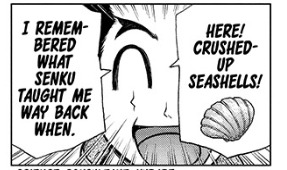
Acidic soil impacts the production of wheat, so by using CaCO3 to neutralize the pH, Taiju “leveled up” the soil to allow for his wheat to grow.
Mortar
The second use of calcium carbonate is to make mortar, specifically lime mortar, which is made by mixing calcium carbonate with sand and water. This was used by various civilizations in the past, such as in the pyramids build by the Ancient Egyptians and in Indian traditional structures, as well as in ancient Rome and Greece. The sand is used as an aggregate, which is some kind of coarse- to medium-grained particulate material that serves to reinforce things like concrete and other composite materials.
Lime mortar is the “predecessor to cement”, referring to Portland cement which is the most common type of cement used today. The process to make Portland cement seems to be more complicated than making lime mortar, and it can cause chemical burns and other nasty health issues. The Wikipedia page I’m pulling this information from has some other neat things such as how to mix and use lime mortar, and some properties of lime mortar compared to Portland cement.
Soap

The third use of calcium carbonate is soap. In the manga, it appears that they made soap using seaweed and crushed shells. I can’t find too much about specifically using seaweed and calcium carbonate to make soap, but it seems that seaweed oil can be used for making soap, among other things. Seaweed can also be processed to yield sodium carbonate (Na2CO3, aka soda ash). Mixing solutions of soda ash and lime (calcium oxide here) makes lye, which is used to make "hot process” soap by adding lye to water, cooling it for a few minutes, and then adding that to oils and butters before cooking it for a few hours and placing it into a mold. I’m not sure if that’s the process that Senku used to make soap, though, since we only get a few panels.
Gunpowder
And the fourth use of calcium carbonate is to make gunpowder. The ingredients for gun powder are listed in Ch 8: sulfur, charcoal, and potassium nitrate. Potassium nitrate (KNO3 aka saltpeter) can be extracted from human and animal manure, once bacteria oxidizes the nitrogen-containing organic material into various nitrate salts. It seems potassium nitrate can also be obtained by immersing guano in water for a day, filtering it, and harvesting the crystals, but that doesn’t seem to use calcium carbonate in the process. What does use calcium carbonate is probably the process of treating the calcium carbonate with nitric acid and neutralizing it with ammonia to produce calcium nitrate
CaCO3 + 2 HNO3 → Ca(NO3)2 + CO2 + H2O
And then mixing the aqueous calcium nitrate with potassium carbonate (aka potash) to produce potassium nitrate.
Ca(NO3)2(aq) + K2CO3(aq) → CaCO3(s) + 2 KNO3(aq)
The charcoal is the thing that burns in the combustion reaction for the gunpowder explosion, but the need for oxygen limits the effectiveness of using charcoal on its own as the inner layers would need to wait for the outer layers to burn away in order to access the oxygen needed for the reaction. One way to mitigate that issue is by grinding up the charcoal into powder in order to increase the surface area, and the second way is to mix the charcoal with an oxidizing agent, in this case potassium nitrate, so that the carbon has easier access to oxygen without needing fresh air. The reaction with potassium nitrate and charcoal also uses sulfur in the following unbalanced equation:
KNO3(s) + C(s) + S(s) → N2(g) + CO2(g) + K2S(s)
Here is the reminder not to make gunpowder on your own, kids, because it’s dangerous.

The sugar mentioned above is also used for combustion. It probably produces more energy compared to burning just charcoal, leading to a bigger explosion.
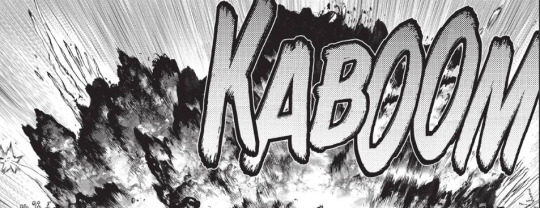
If you have any questions on or corrections to this post, or have any requests for future posts, feel free to send an ask!
Sources
https://en.wikipedia.org/wiki/Calcium_carbonate
Agriculture
https://en.wikipedia.org/wiki/Agricultural_lime
https://www.khanacademy.org/science/biology/water-acids-and-bases/acids-bases-and-ph/a/acids-bases-ph-and-bufffers
https://www.agprofessional.com/article/liming-acid-soils-optimum-wheat-production
Mortar
https://en.wikipedia.org/wiki/Lime_mortar
https://en.wikipedia.org/wiki/Construction_aggregate
https://en.wikipedia.org/wiki/Portland_cement
Soap
https://en.wikipedia.org/wiki/Soap
https://en.wikipedia.org/wiki/Lye
https://en.wikipedia.org/wiki/Edible_seaweed
https://en.wikipedia.org/wiki/Sodium_carbonate
https://cavemanchemistry.com/oldcave/projects/lime/index.html
Gunpowder
https://en.wikipedia.org/wiki/Potassium_nitrate
https://en.wikipedia.org/wiki/Calcium_nitrate
https://en.wikipedia.org/wiki/Potassium_carbonate
https://cavemanchemistry.com/oldcave/projects/gunpowder/
9 notes
·
View notes
Text
Welcome to Senku’s Lab!
This is a sideblog for me to research and explain some of the science that happens in Dr. Stone! And by research I mean fall down a wikipedia hole.
I’m currently working through the steps of developing Ruri’s sulfa drugs. Check out the masterpost for all the sulfa drugs posts I’ve made so far.
If you have any requests for things for me to research, drop it in my askbox!
3 notes
·
View notes